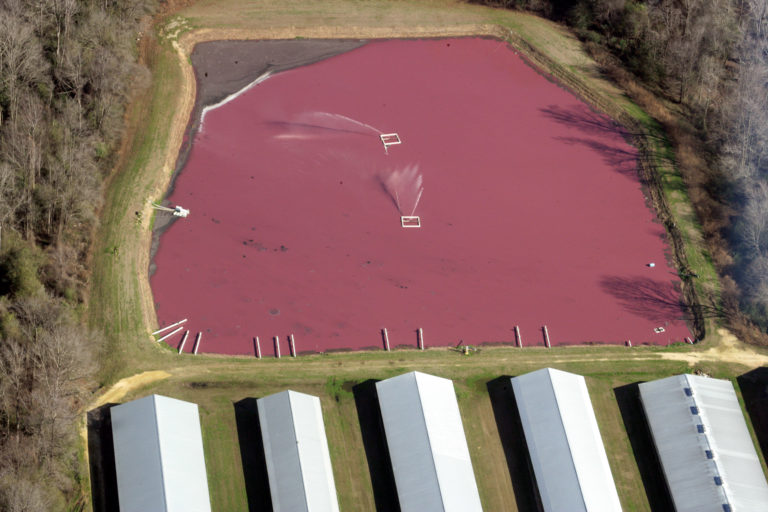Gas from hog waste isn’t clean energy
By: Ellen Simon

The “fix” $15 billion Smithfield Foods is proposing for its hog waste pollution problem — turning hog waste into biogas — isn’t a fix at all.
In fact, it will only make the state’s hog waste pollution problems worse.
The background: North Carolina’s industrial hog operations keep thousands of hogs in confinement; they can live their whole lives without ever poking around outside. The hogs live snout to rump; their urine, blood, and other waste falls through slats in the floor, then is flushed into open cesspools, some the size of Olympic swimming pools. Finally, the waste is sprayed on nearby cropland.
The waste in the cesspools breaks down without oxygen; as a result, the waste generates more methane, a greenhouse gas that’s 25 times more potent than carbon dioxide, than waste from animals that are allowed to graze.
And we’re talking about a lot of waste. North Carolina’s hogs (and its very few cattle) produce 10 billion gallons of waste every single year — and not one drop of it is treated the way human waste is.
Greenhouse gas isn’t the only problem caused by this primitive waste management.
Nearly all of these factory-size hog operations are on the state’s coastal plain, where the soil is porous. Pathogens from all that hog poop leach out into the groundwater table. Emissions from the waste enter the atmosphere as ammonia, then rain down as nitrogen, tainting wells. Excess nitrates in drinking water can cause potentially deadly blue baby syndrome and are also associated with a higher risk of miscarriages.
Excess nitrogen and phosphorus from the cropland where the waste is sprayed run off into our creeks, streams, and rivers, where it can contribute to fish kills and dead zones.
Those open cesspools were supposed to be replaced with something better.
An agreement between Smithfield and the state of North Carolina called for environmentally superior technology to manage waste that was also “economically feasible.”
After C.M. (Mike) Williams, director of the Animal and Poultry Waste Management Center at North Carolina State University led a group that oversaw the selection and testing of hog waste technologies — some of which were highly promising — the industry insisted that none met its economic feasibility standards. So none were ever put into wide use. Despite continued research, improvements in technology, and changes in the marketplace, the economic feasibility of those proven technologies has not been re-evaluated in more than a decade.
But there are better systems than unlined holes in the ground.
It’s possible to generate biogas and address the long-standing pollution problems from industrial hog operations. Duke University, with funding from Google Inc. and Duke Energy, as well as state and private grants, piloted a clean hog-waste to energy project at 8,500-hog Loyd Ray Farms, in Yadkinville, N.C.
The project uses an anaerobic digester that converts swine waste to methane, which is used to fuel a microturbine. It features lined and covered cesspools, which decrease odors and protect groundwater, as well as aeration to reduce the concentration of ammonia.
Producing this clean energy has given the farm a chance to earn a new revenue stream by selling carbon offsets.
But the experiment is closing because it can’t compete with operations that aren’t adequately trying to solve the water pollution problems of large-scale hog operations.
“Capturing biogas without cleaning up the waste is cheaper, for sure,” said Ryke Longest, director of the Environmental Law and Policy Clinic and a clinical professor of Law at the Duke University School of Law. “But you can do both if the true cost of pollution is either placed on the polluter or the taxpayer, instead of the neighbors and rivers.”
By contrast, Smithfield Foods is trying to do biogas on the cheap. Its plan doesn’t protect groundwater by lining hog cesspools.
It doesn’t include aeration to reduce ammonia or address nutrient contamination of soils.
Instead, by simply putting liners over open cesspools, it will increase the amount of nitrogen in the hog waste, threatening the environment even more, since covers increase the nitrogen concentration of waste as ammonia, a gaseous form of nitrogen, gets trapped under the cesspool’s cover.
“I’m concerned that Smithfield’s biogas plan might make water quality worse,” said Cape Fear Riverkeeper Kemp Burdette. “This will do nothing to minimize spraying. This could make groundwater worse by concentrating nitrogen in the cesspools. This won’t require anyone to build a liner. This is corporate profiteering masquerading as an environmental upgrade.”